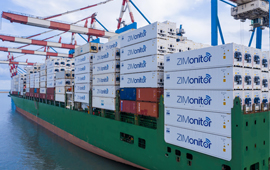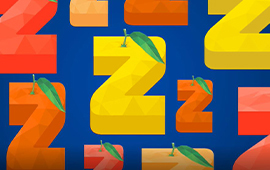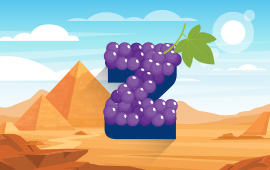Make Way for The King of Thai Fruit
One of the most divisive foods in the world, the durian is also crowned as the notorious “King of Fruits”. This exotic delicacy is an acquired taste, sharply dividing opinions across the world. The controversy behind this wild fruit does not actually come from its rich taste, but rather its legendary aroma. Durian is renowned for its strong lingering smell, which some find quite unpleasant, so much so that it is even banned from public places in Asia.
Durian is the Malay term for “thorn”, due to its distinctive spiny shell. Wrapped within this sharp exterior is a deeply sweet and almost cream-like texture, which for many has become an obsession. The durian varies in size and shape but often grows to the size of a football, weighing about five pounds, and depending on the variety, turns bright green when ripe. This tropical fruit can be served raw or even cooked. In fact, durians are used to make all kinds of sweet treats like durian chips, ice cream and even cakes.
The durian has been cultivated across Southeast Asia for centuries, in countries such as Malaysia, Indonesia, the Philippines, Vietnam, and Thailand, which remains the world’s largest producer of Durian, along with various frozen, dried, and tropical fruits like mango and longan. This eclectic variety certainly fits Thailand’s cold-chain market which has recently experienced tremendous growth of 49% in its fresh fruit commodity.
Thailand’s durian season begins around March but hits its peak between mid-April through June, offering a diverse selection of more than a hundred well-known varieties. We’ve compiled Thailand’s chosen ones, also known as The Big Four:
- The Monthong is the go-to durian variety for locals. It translates to “golden pillow” in Thai and is probably the most widespread in the country, accounting for 41% of all durian exports. They boast a large size along with rich, creamy texture. While this variety is considered one of the least strong in both aroma and flavor, the pieces of fruit inside the shell are huge.
- Next up – Chanee and Kan Yao. The Chanee variety is softer, yet powerful in its smell, and can even get stronger as it matures while the Kan Yao, also known as “long stem durian”, is considered a high-class variety in Thailand.
- Last but certainly not least, is the Gradoomthong, or “golden button”. This variety is oval-shaped and as its name suggests, distinctively smaller than the rest, but has a fragrant tropical taste, which is why this variety has become a favorite for many durian enthusiasts.
Apart from its curious flavor, the appearance and freshness of the durian are among its most critical features. Since durians are harvested at the proper level of maturity and immediately loaded for transport, they require a reliable schedule for just-in-time delivery. Nutthawut Wiwatbutsiri, Reefer Sales Manager of ZIM Thailand described that “the durian is freshly cut from the farm to the container, where unpredictable factors may take place, so customers are looking for a stable loading plan.”
To minimize risks and prevent any unnecessary delays, ZIM Thailand has been working to effectively move sensitive products along the cold chain. The use of refrigerated containers, equipped with an advanced GPS tracking system which monitors the cargo’s every move, is a clear advantage when transporting durian fruits. Also, the fact that ZIM currently holds the youngest fleet (of only 5 years!) in the industry, even further enhances the fruits’ security by providing greater stability for the cargo.
Durian plays a crucial role in Thailand’s economy, since the fruit is much appreciated in its primary export destination – China, where Thailand’s unique varieties quickly captured the people’s appetite. As of 2021, durian exports bound for China reached a staggering 83% of the total reefer market, with highest volumes distributed to Hong Kong as well as Shekou, and Nansha ports in South China’s city of Guangzhou.
However, China’s zero-COVID case policy has also altered this reality. New protocols implemented by the Chinese government have caused traffic jams at various border crossings, where thousands of cargos carrying fresh produce are under inspection. In some cases, borders are closed for days, even weeks, meaning fresh fruits with limited shelf life could be unsuitable for the market.
But things are finally looking up!
The world’s largest trade agreement also known as the Regional Comprehensive Economic Partnership is expected to launch in the very near future. This development will eventually establish a free-trade zone between Thailand and China, among many other export giants, by eliminating 90% of tariffs on all exports. The RCEP agreement marks an important step toward economic growth amid global uncertainties, by enhancing the efficiency of cross-border transport. These simplified customs procedures will allow for immediate clearance of goods, including a guaranteed release of perishable goods within six hours of arrival – still fresh and highly nutrient.
The entire process from harvesting the fruit to refrigerated transportation wouldn’t be as successful as it is without quality service. With ZIM Thailand’s dedicated Reefer Customer Service Team in hand, Thai growers, exporters, and customers can be certain that this group of specialists are committed to safely transport their products. As Nutthawut proudly adds: “Dedication represents the professionalism our commercial team provides.”
So, while it may take some time to get accustomed to the memorable aroma, don’t be too quick to judge the durian, because it’s not going anywhere!





